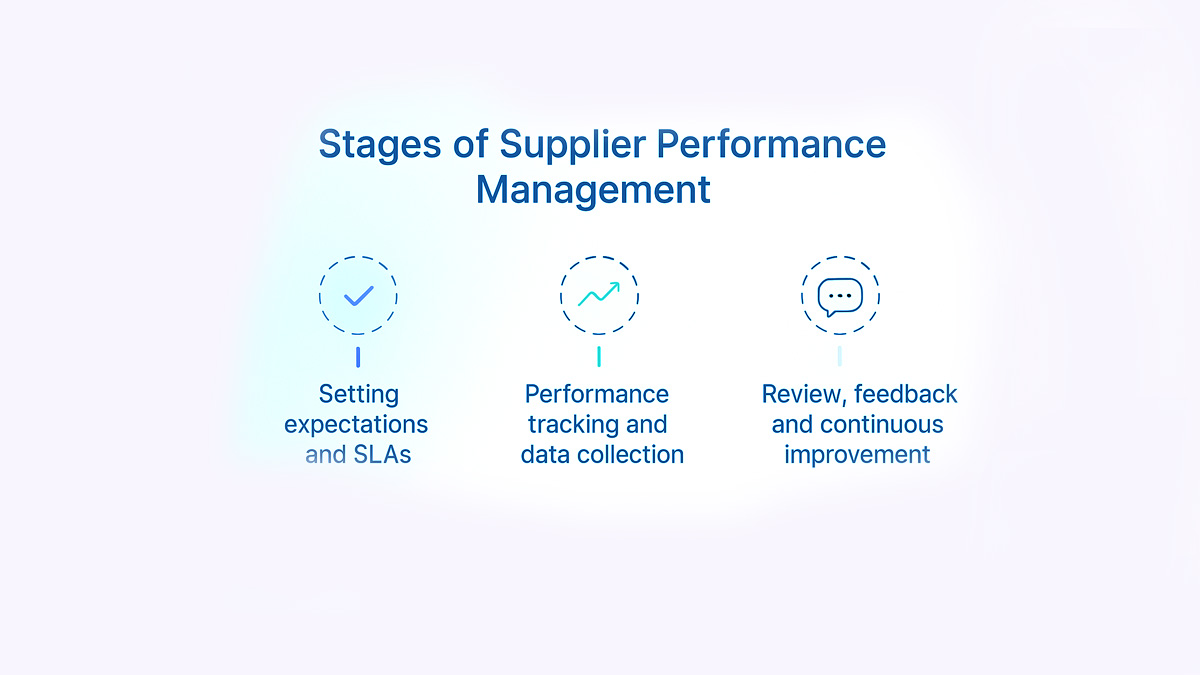

Ultimate Guide to Supplier Performance Management (SPM)
.jpg)
Ultimate Guide to Supplier Performance Management (SPM)
Explore how supplier performance management improves vendor accountability, quality, compliance, and overall procurement efficiency.
.jpg)

Think of your suppliers as the backbone of your business operations. If they falter - delays, quality dips, compliance issues - the ripple effects can be costly. In today’s competitive and global supply chains, businesses can’t afford to “set and forget” supplier relationships. That’s where supplier performance management (SPM) - a key part of supply chain management - comes in.
It’s not just about checking boxes or policing vendors. Done right, SPM is a collaborative effort that ensures suppliers meet expectations, drive cost savings, stay aligned with business goals, and continuously improve. It’s about building strong, data-backed partnerships that drive value - not just savings.
What this blog covers:
- What is supplier performance management?
- Why supplier performance management matters
- Key stages of supplier performance management
- Common challenges in supplier performance management
- Best practices and tools for successful supplier performance management
- How Spendflo helps with supplier performance management
- Frequently asked questions on supplier performance management
What is Supplier Performance Management?
Supplier performance management (SPM) is the structured process of evaluating, monitoring, and improving a supplier’s ability to meet contractual obligations, quality standards, and delivery timelines. It ensures suppliers align with business goals, reduce risk, and support continuous improvement.
Why Supplier Performance Management Matters?
Suppliers are more than just third parties - they’re critical partners in your company’s ability to deliver value. When supplier performance falls short, it doesn’t just affect one team - the ripple effects hit procurement, finance, operations, and ultimately your customers. That’s why supplier performance management (SPM) is more than a compliance checkbox. It’s a strategic necessity.
Improves Quality and Compliance
Consistent monitoring ensures that suppliers meet high-quality standards and follow regulatory requirements. Whether it’s industry certifications, safety protocols, or legal obligations, effective SPM catches non-compliance early - helping avoid product recalls, fines, or reputational damage. It also helps prevent issues like a high defect rate from creeping into the supply chain, saving time and costs later.
Controls Procurement Costs and Reduces Risks
SPM provides the visibility needed to manage procurement costs and strengthen risk management more intelligently. Tracking metrics like delivery timelines, price fluctuations, and payment terms can reveal inefficiencies or hidden spend. More importantly, it helps identify supplier risks - like unreliable vendors or missed SLAs - before they escalate into costly disruptions.
Builds Stronger Supplier Relationships
Performance management isn’t just about catching mistakes - it’s about fostering trust. By engaging suppliers in regular reviews and sharing feedback openly, businesses build stronger partnerships. These relationships are the foundation for better service, improved collaboration, and even innovation opportunities.
Enhances Operational Efficiency
When you know which suppliers are performing well - and which aren’t - you can streamline decision-making. Procurement teams can confidently allocate more business to high-performing vendors and avoid firefighting issues down the line. This leads to faster processes, fewer bottlenecks, and smoother day-to-day operations.
Key Stages of Supplier Performance Management
Supplier performance management isn’t a one-time event - it keeps evolving as your business and supplier landscape change. A solid SPM program typically follows three key stages:

Setting Expectations and SLAs
Before performance can be measured, it must be defined. This stage involves setting clear expectations, outlining KPIs, and formalizing them into Service Level Agreements (SLAs). These could cover delivery timelines, quality standards, compliance needs, or pricing terms - essentially, what “good performance” looks like.
Performance Tracking and Data Collection
With expectations set, the next step is consistent monitoring. This includes gathering real-time and historical data from various touchpoints - procurement systems, delivery logs, quality checks, and even customer feedback. Accuracy here is critical; if the data’s off, so is the analysis.
Review, Feedback, and Continuous Improvement
Regular performance reviews - monthly, quarterly, or project-based - allow teams to assess how suppliers are doing against expectations. Feedback is shared, concerns are addressed, and if needed, improvement plans are put in place. When done well, this stage turns compliance into collaboration.
Together, these stages help businesses move from reactive firefighting to proactive supplier development.
Common Challenges in Supplier Performance Management
Managing supplier performance sounds simple in theory - but in practice, it's often messy, fragmented, and reactive. Here are some of the most common challenges businesses run into:
Lack of Real-Time Data
You can't fix what you can't see. Without accurate, up-to-date data, teams struggle to spot supplier issues early. Many companies still rely on spreadsheets or siloed systems, which makes tracking performance slow, inconsistent, and prone to human error.
Unclear KPIs and Scorecards
If expectations aren’t clearly defined, evaluations become subjective. Are you prioritizing cost, delivery time, or product quality? Without shared KPIs or a supplier scorecard framework, teams end up comparing apples to oranges - and suppliers don’t get actionable feedback.
Weak Communication and Collaboration
Performance management shouldn’t be a one-way street. But often, suppliers only hear from buyers when something goes wrong. A lack of regular communication limits trust and stifles the chance for continuous improvement or shared problem-solving.
Manual, Disconnected Processes
Too much of SPM still lives in email threads and scattered docs. This leads to missed follow-ups, inconsistent reviews, and no single source of truth. Without automation or integration, performance tracking is inefficient and difficult to scale.
Reactive, Not Proactive
Waiting for problems to arise before evaluating a supplier is a recipe for supply chain disruption. Reactive management causes delays, inflated costs, and compliance risks. The best SPM programs are forward-looking - catching risks before they escalate.
To complement performance tracking with real-time risk insights, explore this detailed guide on Supplier Risk Management Software.
Best Practices of Supplier Performance Management
Getting supplier performance right isn’t just about checking boxes - it’s about building systems that make accountability, transparency, and collaboration part of your day-to-day procurement culture. Here’s how leading organizations do it:

Leverage Supplier Scorecards
Scorecards help standardize evaluations by focusing on key performance indicators (KPIs) like delivery timelines, quality metrics, compliance, cost-efficiency, and responsiveness. They allow you to benchmark vendors against each other - and against internal expectations - giving both sides a shared view of performance.
Use Collaborative Improvement Plans
When a supplier underperforms, don’t just issue warnings. Create structured improvement plans with input from both sides. Clearly define what needs to change, assign ownership, and set follow-up review points. This shifts the dynamic from blame to partnership.
Adopt Automation and Real-Time Dashboards
Manual tracking limits visibility and increases risk. Tools like procurement visibility platforms and supplier management software enable real-time performance data monitoring, automated alerts, and centralized documentation. This not only improves supplier data accuracy but also reduces the admin burden on procurement teams.
Align Supplier Performance with Business Goals
SPM shouldn’t operate in a silo. Connect supplier KPIs to broader organizational priorities - whether it’s reducing procurement costs, improving sustainability, or minimizing delivery risk. This alignment ensures suppliers are contributing directly to strategic outcomes, not just fulfilling tasks.
Encourage Two-Way Feedback
Finally, don’t forget to listen. Invite suppliers to share feedback on your processes too. This open loop fosters mutual trust, highlights blind spots, and often uncovers hidden efficiencies or innovations.
SPM works best when it’s structured, tech-enabled, and aligned with supplier relationship management practices. The goal isn’t perfection - it’s progress, together.
How Spendflo Helps with Supplier Performance Management
Spendflo takes the complexity out of supplier performance management by giving you full visibility into your vendor ecosystem - all in one place. Our platform centralizes supplier contracts, performance metrics, and renewal timelines, making it easy to track SLAs, enforce accountability, and catch risks before they escalate.
With real-time dashboards, automated workflows, and benchmark-driven insights, Spendflo empowers procurement and finance teams to make informed decisions, reduce costs, and strengthen vendor relationships. Whether you’re managing five suppliers or fifty, Spendflo simplifies the process - so your team can focus on strategic growth, not operational firefighting.
Frequently Asked Questions on Supplier Performance Management
What are the key benefits of supplier performance management?
SPM helps businesses stay in control of quality, reduce procurement costs, and minimize risk. It fosters stronger vendor relationships through accountability and open communication. Done right, it also improves delivery timelines, boosts operational efficiency, and helps avoid costly disruptions.
How do you measure supplier performance effectively?
Start by identifying key performance indicators (KPIs) based on your goals - like on-time delivery, product quality, compliance with SLAs, or cost efficiency. Use supplier scorecards to track these metrics consistently, and hold regular performance reviews to discuss results and set improvement plans.
What tools or technologies support supplier performance management?
Modern SPM platforms offer real-time dashboards, automated alerts, and centralized documentation. Tools like Spendflo help track vendor contracts, monitor metrics, and flag risks proactively. Integration with your procurement or ERP systems also ensures clean data and faster decision-making.
What happens if a supplier consistently underperforms?
First, address issues through feedback and collaborative improvement plans. If performance doesn’t improve, you may need to renegotiate terms, reduce business volume, or even switch vendors as part of your risk mitigation strategy. The goal is to protect your operations while still giving the supplier a chance to improve.
How often should supplier performance be reviewed?
Ideally, supplier performance should be reviewed quarterly - though high-risk or strategic vendors may require monthly check-ins. Reviews should be structured, data-driven, and prioritized for strategic suppliers, and followed by clear next steps to ensure continuous alignment and accountability.
What role do performance dashboards and trends play in supplier evaluation?
Performance dashboards help visualize performance trends over time, offering real-time insights into supplier strengths and weaknesses. They simplify supplier evaluation by highlighting gaps in performance goals and SLAs, making it easier to take action. This kind of transparency supports better decision-making across vendor management and procurement teams.
How does supplier engagement impact inventory and customer service?
Strong supplier engagement ensures more accurate delivery timelines, better coordination, and smoother inventory management. When suppliers understand your business needs and respond proactively, it leads to fewer stockouts, quicker turnarounds, and ultimately - better customer service. Effective feedback loops with your supply base are essential to building this kind of responsiveness.










.png)




.png)










.avif)





